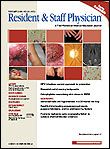New Combination Antihypertensive Therapy with 2 Proven Mechanisms of Action
According to the American Heart Association, as many as 72 million American adults have elevated blood pressure (BP), and many of them do not know they have it. Despite the abundance of antihypertensive medications monotherapies as well as combination agents the rates of BP control among hypertensive patients in the United States are not encouraging. Even among those who are being treated, achieving a BP goal of <140/90 mm Hg has proved elusive, with only about one third of patients reaching their therapeutic goals. Many patients will eventually take more than 1 antihypertensive, which may in part explain the increasing emphasis on combination tablets for hypertension.
Last fall, the US Food and Drug Administration approved a new antihypertensive agent called Exforge, which combines the angiotensin receptor blocker valsartan and the calcium channel blocker amlodipine.
As with most combination agents, the 2 components are complementary: valsartan blocks the renin-angiotensin system (RAS), and amlodipine blocks the calcium channel and affects vasomotor tone more strongly. The combination of another RAS blocker, which combines the angiotensin-converting-enzyme (ACE) inhibitor benazepril HCl and amlodipine, has been shown to be an effective antihypertensive therapy in real-world settings.
Several other combination antihypertensives include a diuretic, because diuretics are considered to be the base of therapy, according to current guidelines. And since patients respond to different drugs in a variety of ways, physicians often prescribe one medication and then switch to another that is better tolerated by the individual patient.
The approval of this new combination agent was based on placebo-controlled and active-controlled trials. In one study that randomized patients with stage 2 hypertension to amlodipine (5-10 mg/d) plus valsartan (160 mg/d) or the ACE inhibitor lisinopril (10-20 mg/d) plus the diuretic hydrochlorothiazide for a period of 6 weeks, similar results were seen with both combinations:
- Reduction in mean sitting systolic BP (SBP) of 35.8 mm Hg with amlodipine/valsartan and 31.8 mm Hg with lisinopril/hydrochlorothiazide
- Response rates of mean sitting diastolic BP (DBP) <90 mm Hg, or a ≥10-mm Hg reduction from baseline of 100% and 95.5%, respectively
- DBP control rates of 79.7% and 77.3%, respectively
- Both combination agents were well-tolerated.
Another report assessed the results of 2 multicenter, 8-week, placebo-controlled trials that evaluated amlodipine and valsartan, alone or in combination. Study 1 randomized 1911 patients to amlodipine (2.5 or 5.0 mg/d), valsartan (40-320 mg/d), the combination of both agents across the same dose ranges, or placebo.
Study 2 randomized 1250 patients to amlodipine (10 mg/d), valsartan (160 or 320 mg/d), the combination of both agents across the same dose ranges, or placebo. All participants in both studies had mild-to-moderate essential hypertension at baseline, and all underwent an initial 2-week washout period, during which any current antihypertensive medications were discontinued.
In both trials, the combination regimens—except for a few that included the lowest amlodipine dose of 2.5 mg—resulted in greater reductions in mean sitting DBP and SBP compared with the individual components.
Subgroup analyses of these 2 trials showed similar results in patients with stage 1 hypertension (140-159/90-99 mm Hg) or stage 2 hypertension (≥160/100 mm Hg), the elderly, and African Americans.
The combination regimen was well-tolerated. Combining valsartan with amlodipine significantly decreased the dose-limiting side effect of peripheral edema seen with amlodipine monotherapy.
The daily doses of the new combination tablet are 5 to 10 mg amlodipine and 160 to 320 mg valsartan. The drug is currently not indicated for initial therapy of hypertension. It also should not be prescribed for patients with severe renal disease or for pregnant women. It can be used in those with mild renal disease and in patients with diabetes.
In placebo-controlled trials, 1.8% of patients treated with Exforge discontinued therapy because of side effects, compared with 2.1% of placebo-treated patients.
The most frequently reported side effects with the new combination were peripheral edema (5.4%), nasopharyngitis (4.3%), upper respiratory tract infection (2.9%), and dizziness (2.1%).
